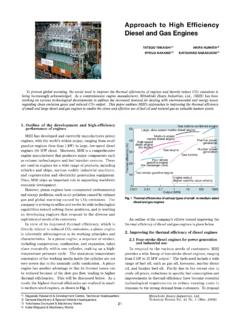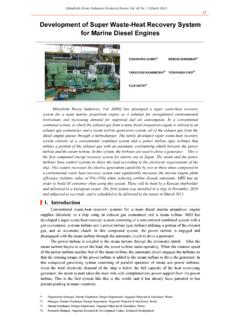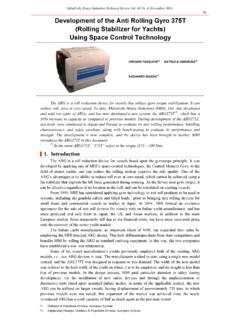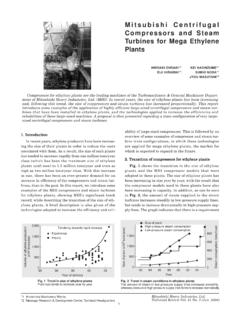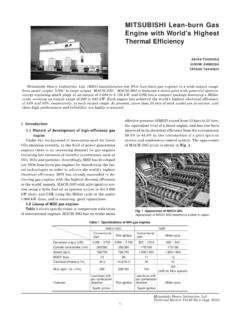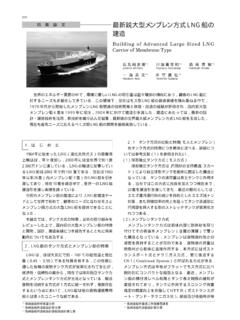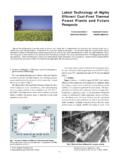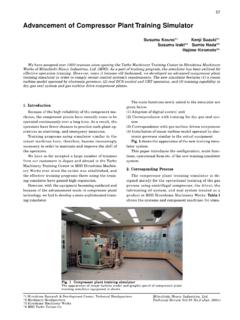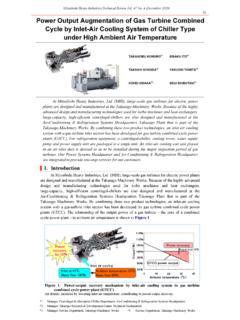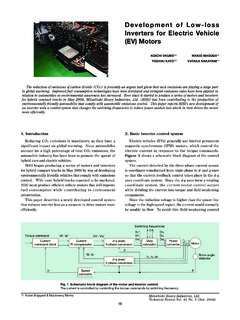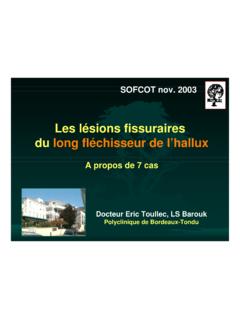Transcription of Developments in Spent Fuel Transport and Storage …
1 Mitsubishi Heavy Industries, Review Vol. 43 No. 4 (Dec. 2006)1 Developments in Spent FuelTransport and Storage CasksFor Spent fuel interim Storage , safe and cost-effective Storage and Transport casks are demanded. To respond tothis demand, Mitsubishi Heavy Industries (MHI) is proceeding with the strategic product development program ofmaterials and manufacturing technology, including demonstration tests with a full-scale drop test model. Untilnow, MHI's technological Developments in this field have focused on aluminum alloys for baskets, neutron shieldingmaterials (resins), and a monolithic forging method for the main body shell.
2 Through this research, MHI has alsocomprehensively demonstrated cask safety by conducting full-scale cask drop tests based on the Regulations for theSafe Transport of Radioactive Materials of IAEA. The MSF Transport and Storage casks ( MSF-57B, MSF-26P)are the fruit of this Introduction1. Introduction1. Introduction1. Introduction1. IntroductionThe high burnup of Spent fuel with high decay heatin overseas nuclear power plants requires the use of highperformance casks for Transport and Storage . The con-struction of the first commercial Spent fuel interimstorage facility (recyclable-fuel Storage facility) in Ja-pan is becoming a reality, and a safe and cost-effectivecask is has strategically developed the materials andmanufacturing technology to be used for cask manufac-turing to ensure full compliance with the requirementsof domestic and foreign market environments.
3 The safetyof the developed casks has been demonstrated throughdrop tests with full scale and subscale cask models, basedon IAEA Transport Regulations. These technologicaldevelopments have culminated in the MSF dry type spentfuel Transport and Storage cask fleet (referred to belowas the MSF cask).In this paper, we report the features of the MSF caskand its technological Outline of the MSF cask2. Outline of the MSF cask2. Outline of the MSF cask2. Outline of the MSF cask2. Outline of the MSF caskThe MSF cask has been developed for the safe andcost-effective interim Storage of Spent fuel generated fromdomestic and overseas nuclear power plants.
4 The caskis designed to comply with the requirements of bothtransport and Storage , including IAEA Transport Regu-lations, and all laws, ordinances, and standards of thecountries where it is used, also factors such as the de-sign conditions specific to the site. Figure 1 Figure 1 Figure 1 Figure 1 Figure 1 gives anoverview of the MSF cask and TTTTT able 1able 1able 1able 1able 1 lists its main speci-fications. Its main features are summarized as 1 An overview of the MSF Cast FleetNeutron shielding material (epoxy resin)Bottom shock absorber (balsa etc.)Heat conductor plate (copper)Main body shell (forged low alloy steel) ASTM A 350 Metal gasket (aluminum, etc.)
5 Trunnion (stainless steel)Outer shell(carbon steel)Basket (boron added aluminum alloy) ASME Code Case N-673 Primary lid (low alloy steel) Top shock absorber (balsa etc.)Secondary lid (low alloy steel) B (U)10 x10 BWR56349 125 /140* x B (U)10 x10 126 /141* x (U)18 x18 PWR 41 121 /136* x B (M)17 x17 /140* x 1 The specifications of the MSF Cask Fleet* : Weight (including the shock absorbers for Transport )TypeFuel typePayloadCooling period (years)U-235 enrichment (%) Maximum burnup (GWd/t)Calorific value (kW)Weight (t)Dimensions (m)MSF-57 B557 MSF-69 B969 MSF-21 P621 MSF-26 P 1526 TOMOFUMI YAMAMOTO*1 SUGURU HODE*2 YOSHIHARU KAMIWAKI*2 HIROKI TAMAKI*2 TOSHIHIRO MATSUOKA*2 KIMINOBU HOJO*3 Nuclear Energy Systems HeadquartersKobe Shipyard & Machinery WorksTakasago Research & Development Center, Technical Headquarters*1*2*32 Mitsubishi Heavy Industries, Review Vol.
6 43 No. 4 (Dec. 2006) .Boron-containing aluminum alloy basket made withpowder metallurgy (developed by MHI) .Forged low alloy steel main body shell (monolithicforging for overseas cask, developed by MHI) .Double lid closure system with metallic gasket (ter-tiary lid for Japan market) .Epoxy resin neutron shielding material (developedby MHI) .High performance shock absorber (developed byMHI, attached to the top and bottom of cask duringtransport)3. Technology development program3. Technology development program3. Technology development program3. Technology development program3. Technology development programThe cask must satisfy four safety functions: (1) con-tainment (containment of radioactive materials), (2)shielding (shielding of radiation), (3) prevention of criti-cality (maintenance of sub-criticality), and (4) heatremoval (dissipation of decay heat).
7 The appropriatestructural strength is required to ensure that the safetyfunctions maintain their intended purposes. An assumedinterim Storage period of 40 to 60 years will require thereliable maintenance of each the viewpoint of economy, the cask should ac-commodate an increased number of fuel assemblies andincorporate weight saving design features and safetyfunction enhancements. The simplified cask design andstructure realize the reduction of the man-hours requiredfor manufacture and development items for the MSF cask were de-termined through the evaluation of several issues withrespect to the above enhancements of safety functionsand economy.
8 Figure 2 Figure 2 Figure 2 Figure 2 Figure 2 shows the relation betweenthe safety functions and cask structure. TTTTT able 2able 2able 2able 2able 2 showsthe relation between the various issues considered, in-cluding economy and the development following section gives an overview of the de-velopment items selected.(1) ContainmentThe containment system consists of lids, a mainbody shell and its flange, and metal gaskets. Theperformance and structural strength of the sealingsystem must be verified to meet the requirementsfor both Transport and Storage . In addition, the ag-ing deterioration due to heat and corrosion needsto be considered from the viewpoint of long termintegrity.
9 (2) ShieldingGamma ray and neutron radiation are shieldedwith the thick forged steel of the main body shelland the neutron shield installed around the mainbody. The issue to be verified from the viewpoint oflong-term Storage will be the aging deterioration ofTable 2 Technology Developments in relation to economy and safety functions Safety functionsIssuesTechnology developmentsIssuesEconomyContainmentShie ldingSub-criticalityHeatdissipationStruc tural integrityValidation of containment and structural integrity, and long-term integrityStability duringlong term Storage Material strength, boron content, and aging effectImprovement of basketheat conductionValidation of safety functions Structural evaluationof welding Vacuum drying technologyNeutron shielding material (heat resistance and long term stability)Boron added aluminum alloyDemonstration and verification by drop testsMonolithic forging methodApplying core-effectivematerialsReduction of cask (packaging) weight Simplification of cask structureReduction of the manufacturing processMaterialsPayloadManufacturing and inspectionFig.
10 2 Safety functions of the caskRelation between the cask structure and safety functionsContainmentPrimary lidSecondary lidBody flangeMetal gasketSub-CriticalityBasket (Geometric layout)Neutron absorber (boron)ShieldingMain body shellNeutron shielding materialHeat dissipationBasketMain body shellHeat conductor platesOuter shellSecondary lidand metal gasketPrimary lid and metal gasketBody flangeMain body shellNeutronshieldingOuter shellBasketHeat conductor platesMitsubishi Heavy Industries, Review Vol. 43 No. 4 (Dec. 2006)3the high polymer materials used for the neutronshielding.(3) Sub-criticalityThe prevention of criticality is realized with themaintenance of the geometric layout of fuels by thebasket and the neutron absorbing material containedin the basket.
